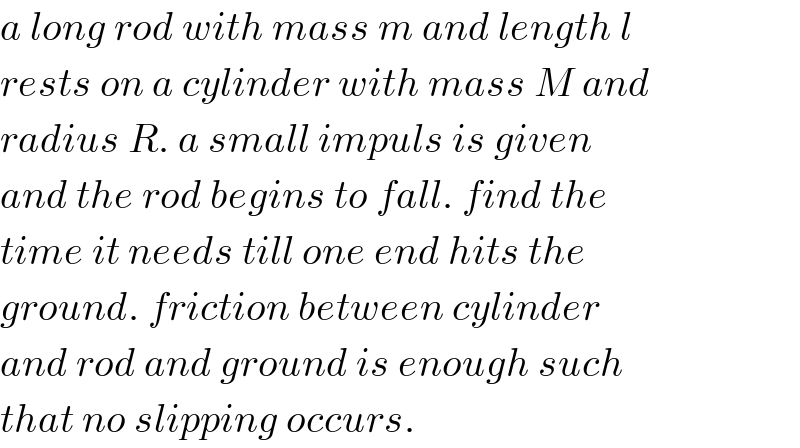Question Number 91167 by mr W last updated on 28/Apr/20

Commented by mr W last updated on 28/Apr/20

$${also} \\ $$
Commented by mr W last updated on 28/Apr/20

$${a}\:{long}\:{rod}\:{with}\:{mass}\:{m}\:{and}\:{length}\:{l} \\ $$$${rests}\:{on}\:{a}\:{cylinder}\:{with}\:{mass}\:{M}\:{and} \\ $$$${radius}\:{R}.\:{a}\:{small}\:{impuls}\:{is}\:{given} \\ $$$${and}\:{the}\:{rod}\:{begins}\:{to}\:{fall}.\:{find}\:{the} \\ $$$${time}\:{it}\:{needs}\:{till}\:{one}\:{end}\:{hits}\:{the} \\ $$$${ground}.\:{friction}\:{between}\:{cylinder} \\ $$$${and}\:{rod}\:{and}\:{ground}\:{is}\:{enough}\:{such} \\ $$$${that}\:{no}\:{slipping}\:{occurs}. \\ $$
Commented by jagoll last updated on 28/Apr/20

$${physics}\:{sir}? \\ $$
Commented by ajfour last updated on 29/Apr/20

$${very}\:{difficult}\:{one}\:{sir},\:{point}\:{of} \\ $$$${contact}\:{of}\:{cylinder}\:{and}\:{plank}\:\left({rod}\right) \\ $$$${shall}\:{go}\:{on}\:{changing}\:{too},\:{many} \\ $$$${interdependent}\:{things}..! \\ $$
Answered by mr W last updated on 28/Apr/20

Commented by mr W last updated on 29/Apr/20
![rotation of cylinder ϕ rotation of rod θ OC=Rϕ PS=R(ϕ−θ) rod hits the ground if [(l/2)+R(ϕ−θ)]tan (θ/2)=R x_S =Rϕ+R sin θ+R(ϕ−θ)cos θ y_S =R cos θ−R(ϕ−θ)sin θ v_(Sx) =R[(dϕ/dt)+cos θ(dθ/dt)+((dϕ/dt)−(dθ/dt))cos θ−(ϕ−θ)sin θ(dθ/dt)] v_(Sx) =R[(dϕ/dt)(1+cos θ)−(ϕ−θ)sin θ(dθ/dt)]](https://www.tinkutara.com/question/Q91257.png)
$${rotation}\:{of}\:{cylinder}\:\varphi \\ $$$${rotation}\:{of}\:{rod}\:\theta \\ $$$${OC}={R}\varphi \\ $$$${PS}={R}\left(\varphi−\theta\right) \\ $$$${rod}\:{hits}\:{the}\:{ground}\:{if} \\ $$$$\left[\frac{{l}}{\mathrm{2}}+{R}\left(\varphi−\theta\right)\right]\mathrm{tan}\:\frac{\theta}{\mathrm{2}}={R} \\ $$$$ \\ $$$${x}_{{S}} ={R}\varphi+{R}\:\mathrm{sin}\:\theta+{R}\left(\varphi−\theta\right)\mathrm{cos}\:\theta \\ $$$${y}_{{S}} ={R}\:\mathrm{cos}\:\theta−{R}\left(\varphi−\theta\right)\mathrm{sin}\:\theta \\ $$$$ \\ $$$${v}_{{Sx}} ={R}\left[\frac{{d}\varphi}{{dt}}+\mathrm{cos}\:\theta\frac{{d}\theta}{{dt}}+\left(\frac{{d}\varphi}{{dt}}−\frac{{d}\theta}{{dt}}\right)\mathrm{cos}\:\theta−\left(\varphi−\theta\right)\mathrm{sin}\:\theta\frac{{d}\theta}{{dt}}\right] \\ $$$${v}_{{Sx}} ={R}\left[\frac{{d}\varphi}{{dt}}\left(\mathrm{1}+\mathrm{cos}\:\theta\right)−\left(\varphi−\theta\right)\mathrm{sin}\:\theta\frac{{d}\theta}{{dt}}\right] \\ $$
